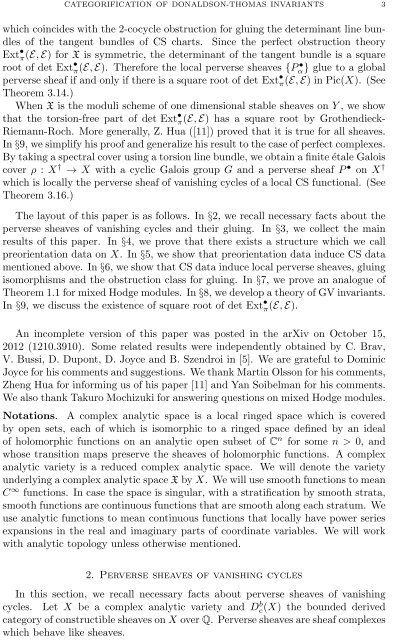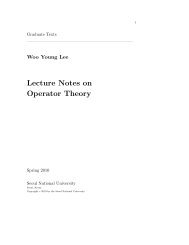Categorification of Donaldson-Thomas invariants via perverse ...
Categorification of Donaldson-Thomas invariants via perverse ...
Categorification of Donaldson-Thomas invariants via perverse ...
Create successful ePaper yourself
Turn your PDF publications into a flip-book with our unique Google optimized e-Paper software.
CATEGORIFICATION OF DONALDSON-THOMAS INVARIANTS 3which coincides with the 2-cocycle obstruction for gluing the determinant line bundles<strong>of</strong> the tangent bundles <strong>of</strong> CS charts. Since the perfect obstruction theoryExt • π(E, E) for X is symmetric, the determinant <strong>of</strong> the tangent bundle is a squareroot <strong>of</strong> det Ext • π(E, E). Therefore the local <strong>perverse</strong> sheaves {P α} • glue to a global<strong>perverse</strong> sheaf if and only if there is a square root <strong>of</strong> det Ext • π(E, E) in Pic(X). (SeeTheorem 3.14.)When X is the moduli scheme <strong>of</strong> one dimensional stable sheaves on Y , we showthat the torsion-free part <strong>of</strong> det Ext • π(E, E) has a square root by Grothendieck-Riemann-Roch. More generally, Z. Hua ([11]) proved that it is true for all sheaves.In §9, we simplify his pro<strong>of</strong> and generalize his result to the case <strong>of</strong> perfect complexes.By taking a spectral cover using a torsion line bundle, we obtain a finite étale Galoiscover ρ : X † → X with a cyclic Galois group G and a <strong>perverse</strong> sheaf P • on X †which is locally the <strong>perverse</strong> sheaf <strong>of</strong> vanishing cycles <strong>of</strong> a local CS functional. (SeeTheorem 3.16.)The layout <strong>of</strong> this paper is as follows. In §2, we recall necessary facts about the<strong>perverse</strong> sheaves <strong>of</strong> vanishing cycles and their gluing. In §3, we collect the mainresults <strong>of</strong> this paper. In §4, we prove that there exists a structure which we callpreorientation data on X. In §5, we show that preorientation data induce CS datamentioned above. In §6, we show that CS data induce local <strong>perverse</strong> sheaves, gluingisomorphisms and the obstruction class for gluing. In §7, we prove an analogue <strong>of</strong>Theorem 1.1 for mixed Hodge modules. In §8, we develop a theory <strong>of</strong> GV <strong>invariants</strong>.In §9, we discuss the existence <strong>of</strong> square root <strong>of</strong> det Ext • π(E, E).An incomplete version <strong>of</strong> this paper was posted in the arXiv on October 15,2012 (1210.3910). Some related results were independently obtained by C. Brav,V. Bussi, D. Dupont, D. Joyce and B. Szendroi in [5]. We are grateful to DominicJoyce for his comments and suggestions. We thank Martin Olsson for his comments,Zheng Hua for informing us <strong>of</strong> his paper [11] and Yan Soibelman for his comments.We also thank Takuro Mochizuki for answering questions on mixed Hodge modules.Notations. A complex analytic space is a local ringed space which is coveredby open sets, each <strong>of</strong> which is isomorphic to a ringed space defined by an ideal<strong>of</strong> holomorphic functions on an analytic open subset <strong>of</strong> C n for some n > 0, andwhose transition maps preserve the sheaves <strong>of</strong> holomorphic functions. A complexanalytic variety is a reduced complex analytic space. We will denote the varietyunderlying a complex analytic space X by X. We will use smooth functions to meanC ∞ functions. In case the space is singular, with a stratification by smooth strata,smooth functions are continuous functions that are smooth along each stratum. Weuse analytic functions to mean continuous functions that locally have power seriesexpansions in the real and imaginary parts <strong>of</strong> coordinate variables. We will workwith analytic topology unless otherwise mentioned.2. Perverse sheaves <strong>of</strong> vanishing cyclesIn this section, we recall necessary facts about <strong>perverse</strong> sheaves <strong>of</strong> vanishingcycles. Let X be a complex analytic variety and Dc(X) b the bounded derivedcategory <strong>of</strong> constructible sheaves on X over Q. Perverse sheaves are sheaf complexeswhich behave like sheaves.













